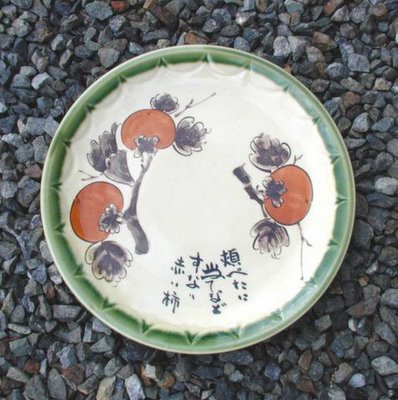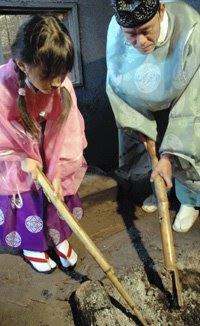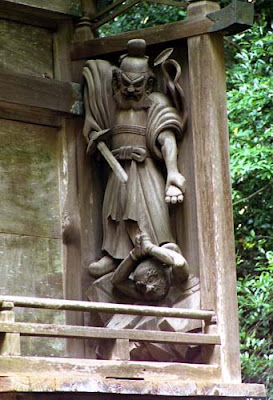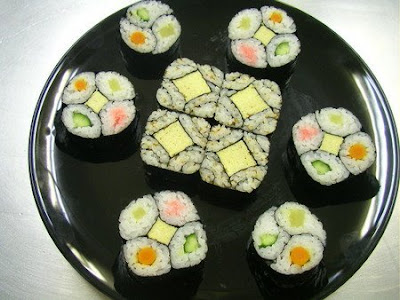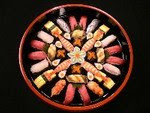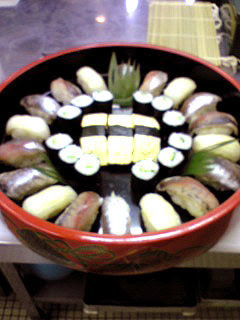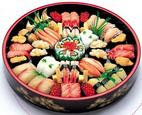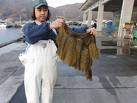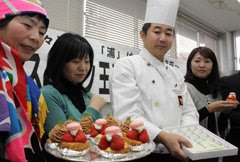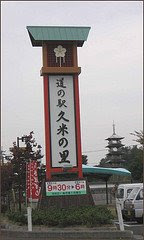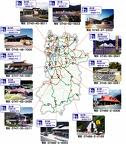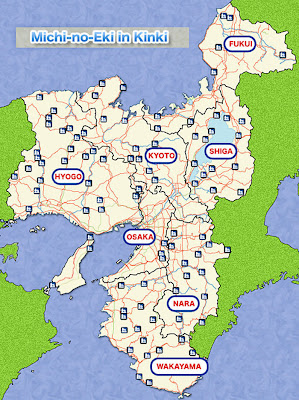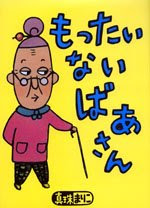::::::::::::::::::::::::::::::::::::::::::::::::::::::::::::::::::::::::::::::::::::::::::::::::::::
Edo-Vegetables (Edo yasai)
The special vegetables grown in Edo (and still now in Tokyo) to feed the shoogun and the inhabitants of Edo castle and the whole town.
Edo dentoo yasai 江戸伝統野菜
Traditional vegetables of Edo
Edo Tokyo Yasai 江戸東京野菜
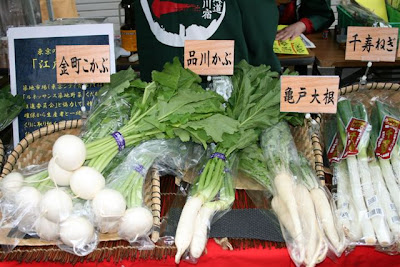
. Edo no takenoko 江戸の筍 bamboo shoots in Edo .
:::::::::::::::::::::::::::::::::::::::::::::::::::::::::::::::::::::::::::::::::::::::::::::::::::

Kameido daikon 亀戸大根 large radish from Kameido
it grows about 30 long, a small daikon. It is very white and was loved for its color, an early spring harbinger.
.... Nerima daikon 練馬大根 from Nerima
has been introduced by Tokugawa Tsunayoshi, 5th shogun, to help feed the growing population of Edo. It is usually prepared as takuan pickles.
The radish is scrabbed with the skin of shark fish (dry skin is soaked in water to make it softer), then pickled in rice bran. Thus the vitamiens of the rice bran would soak easily into the radish.
For the poor people of Edo this was a cheap way to prevent beri-beri disease, which was caused by the polished white rice.
. . . CLICK here for Photos !
quote
The most famous of the daikons of Edo is the Nerima daikon. High in fiber, it is perfect for making takuan pickles. The crispy takuan made with Nerima daikon was a favorite of the Edoites and helped artisans and laborers supplement the salt that they had sweat away.
The Kameido daikon, first cultivated in the Kameido area during the Bunkyu era (1861-64), is another famous daikon of Edo. It was favored by Edoites as an early spring vegetable for its dense flesh and the suitability of both root and leaves for pickling.
The Miura Peninsula in Kanagawa Prefecture has also been a center of Japanese radish production for ages, as evidenced by documents dating as far back as 1841. The Miura daikon, which would later become a big name in the vegetable world, is a natural hybrid between the Nerima daikon and locally grown varieties, such as the Koenbo and Nakabukura.
The Nerima, Kameido, and Miura daikons were all popularly cultivated until the middle or latter half of the Showa era (1926-1989) and formed the cornerstones of a rich food culture. But their production would soon plummet. Diseases and natural disasters, the urbanization of former farmland, the hassle of harvesting, changes in consumer diets, and the expansion of nuclear families all undermined the production of these local varieties.
source : www.tokyofoundation.org / Daikon
:::::::::::::::::::::::::::::::::::::::::::::::::::::::::::::::::::::::::::::::::::::::::::::::::::::

CLICK for enlargement
:::::::::::::::::::::::::::::::::::::::::::::::::::::::::::::::::::::::::::::::::::::::::::::::::::::
Edogawa ward
komatsuna こまつな (小松菜) leafy vegetabel, like spinach
Brassica campestris
from Edogawa 江戸川区小松川 Edogawa Komatsugawa
Has been grown there since Shogun Yoshimune ordered it.
Komatsuna, or spinach mustard,
is commonly eaten during the New Year. In season from November through March, nearly 10,000 tons of spinach mustard is produced yearly in Edogawa Ward. Komatsuna gets its name from the Komatsugawa district, which includes Edogawa, Katsushika and Adachi wards. Tokyo was the second-largest regional producer of komatsuna in 2004.
The hardy green vegetable tastes best in winter, when its leaves become rich in flavor. Komatsuna is served blanched or in zoni boiled rice cake soup. Demand for komatsuna peaks around this time of the year.
source : www.metro.tokyo.jp / with PHOTO

. Komatsugawa district 小松川 "river Komatsu" .
Edogawa ward
:::::::::::::::::::::::::::::::::::::::::::::::::::::::::::::::::::::::::::::::::::::::::::::::::::::
Koganei 小金井
They grow some kinds of old vegetables.
Most is grown in hothouses near the homes of the farmers and now used for bringing life back into the community (machiokoshi, machi okoshi).
nagakabu 長カブ long turnips
. . . CLICK here for Photos !
noraboona のらぼう菜 leafy vegetable
. . . CLICK here for Photos !
ookura daikon 大蔵大根(おおくらだいこん)extra large radish
It grows up to 50 cm lenght and is very compact. Good for boiling, since it does not change its form.
. . . CLICK here for Photos !
shintorina しんとりな / しんとり菜 leafy stem vegetable
. . . CLICK here for Photos !
. Koganei 小金井 Koganei district .
:::::::::::::::::::::::::::::::::::::::::::::::::::::::::::::::::::::::::::::::::::::::::::::::::::::
Kanamachi kokabu 金町こかぶ / 金町小かぶ
small turnips from Kanamachi
. . . CLICK here for Photos !
Magome 馬込 from Magome
Magome sansui ninjin 馬込三寸人参(まごめさんすんにんじん)
Magome hanjiro kyuuri 馬込半白胡瓜(まごめはんじろきゅうり
. Magome - photos of vegetables .
Naitoo kabocha ないとうかぼちゃ / 内藤(ないとう)かぼちゃ
pumpkin from Naito
. . . CLICK here for Photos !
Senjuunegi, Senjuu negi 千住葱 leek from Senju, Senjunegi 千寿葱
They are best when simply grilled over charcoal.
Shinagawa kabu 品川カブ turnips from Shinagawa
. . . CLICK here for Photos !
Takinogawa ninjin 滝野川人参(たきのがわにんじん)
carrots from Takinogawa
Terashima nasu 寺島なす eggplants from Terashima
udo, Tokyo udo 東京うど udo from Tokyo
Aralia cordata Thunb
yama udo 山独活 Mountain spikenard
"mountain asparagus". A mountain vegetable which produces fat, white, edible stalks.
Its tender stalks are similar to asparagus, their flavor is a light fennel. It is also one of the "Kyoto Vegetables".
Peel the outer layer of the stem, cut in oblong pieces, soak in vinegar-water and dry. Eat with vinegared dressings or vinegar miso. The very top of the plant can be used for tempura.
 It is grown deep under the earth about 4 meters deep in long tunnels (udo muro "独活室”) in Tachikawa 立川.
It is grown deep under the earth about 4 meters deep in long tunnels (udo muro "独活室”) in Tachikawa 立川.Very crunchy to the taste (shakishaki, knusprig).
Locally it is served as udo ramen soup 独活ラーメン or in a dressing with salmon like a western asparagus salad (Spargelsalat).
Other specialities from Tachikawa 立川ウド are
udo arare
Kichijoji Udo 吉祥寺ウド is also known.
udo senbei
udo yookan
udo dorayaki
udo pai
. . . CLICK here for Tachikawa Udo Photos !
moyashi udo もやしうど white udo sprouts
A whole group of local farmers continue with the growing of this udo and develop new dishes with it.
udo ae, udo-ae 独活和 (うどあえ) spikenard in dressing
kigo for late spring
udo no kinpira うどのきんぴら boiled in soy sauce and sugar
. . . CLICK here for Photos !
Western asparagus is called "seiyoo udo" 西洋独活.
nanka udo なんかウド/ 軟化独活 soft white udo
grown in Tochigi in special trenches in the dark and harvested three times a year.
They made it to a local speciality, with udo gyooza 独活餃子 at the local chinese restaurant.
. . . CLICK here for Photos !
:::::::::::::::::::::::::::::::::::::::::::::::::::::::::::::::::::::::::::::::::::::::::::::::::::::
Waseda myooga 早稲田茗荷 Myoga from Waseda
Yanaka shooga 谷中生姜 ginger from Yanaka
*****************************
Worldwide use
*****************************
Things found on the way
Tokyo Pigs
Tokyo X buta 東京X豚 Tokyo X pork from special pigs
. . . CLICK here for Photos !
Tokyo-X is a new Japanese breed, bred for high quality pork production. It is unusual for its marbled meat, seldom seen in pork.
Breeding Tokyo-X started in 1990 by the Tokyo Metropolitan Livestock Experiment Station. They combined bloodlines from the Duroc (USA), Berkshire (UK) and a Beijing Black (China) breeds. After five generations of breeding and selection, the first meat was marketed in 1997.
Often processed into a Tokyo Curry.
*****************************
Related words

Edo Tokyo Yasai 江戸東京野菜
***** WASHOKU : Kyooyasai 京野菜 Vegetables from Kyoto
***** . 100 Favorite Dishes of Edo - 江戸料理百選
***** . Tokyo - Local Dishes
***** WASHOKU : INGREDIENTS
WASHOKU : General Information
:::::::::::::::::::::::::::::::::::::::::::::::::::::::::::::::::::::::::::::::::::::::::::::::::::::::::::::::::::::::::::
. Edo 青物町 Aomonocho "vegetable" district .
Edo no Aomono Ichiba 江戸の青物市場 Vegetable Markets in Edo
In the "three vegetable district" 青物三ケ町 Aomono Sangamachi in Kanda
Tachō, 多町 Tacho - 連雀町 Renjakucho - 永富町 Eifukucho
- - - aomono uri 青物売り vegetable vendor
[ . BACK to DARUMA MUSEUM TOP . ]
[ . BACK to WORLDKIGO . TOP . ]
:::::::::::::::::::::::::::::::::::::::::::::::::::::::::::::::::::::::::::::::::::::::::::::::::::::::::::::::::::::::::::






